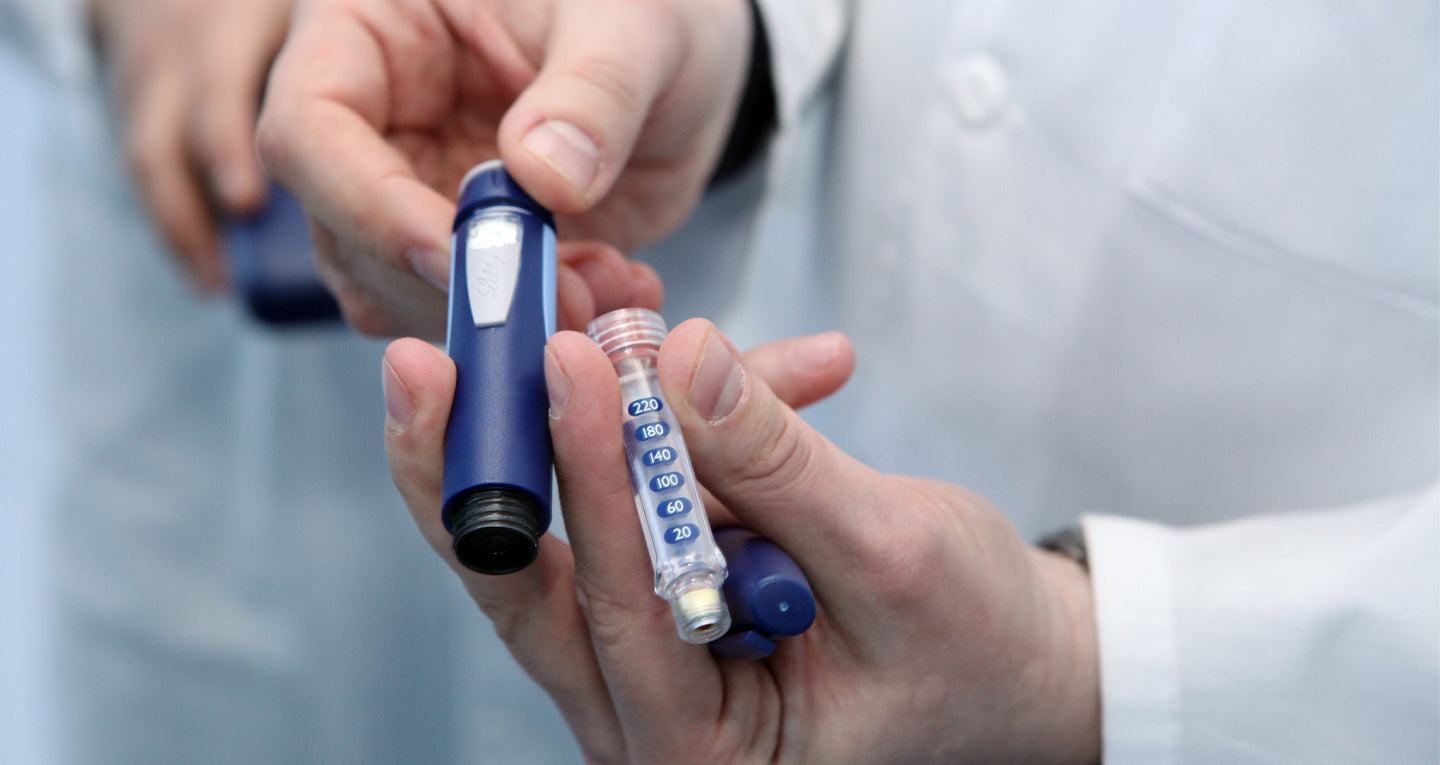Read time: 7 minutes
- GLP-1 agonists are a class of medication used to treat type 2 diabetes by regulating blood sugar levels and suppressing appetite. Some are also approved for weight loss.
- Ozempic (semaglutide) and Victoza (liraglutide) are examples of popular GLP-1 agonists approved for type 2 diabetes, while Wegovy (semaglutide) and Saxenda (liraglutide) are approved for weight loss.
- Important factors to consider when choosing a GLP-1 agonist include age, treatment goals, underlying conditions, dosing preferences, and insurance coverage.
If you are living with diabetes, you may have heard of GLP-1 agonists (“GLP-1s” for short), like Ozempic (semaglutide), Trulicity (dulaglutide), or Victoza (liraglutide). Historically prescribed for blood sugar management, GLP-1s are now widely considered a breakthrough weight loss medication for people with and without diabetes. Today, more than 10 FDA-approved GLP-1s are on the market, with more in development.
In this article, we’ll explore the most popular GLP-1s to help you decide which might best fit your needs.
What is a GLP-1 Agonist?
GLP-1 agonists are a class of medication utilized to treat type 2 diabetes and obesity. They work by mimicking the effects of GLP-1 (glucagon-like peptide-1), a naturally occurring hormone in the body that helps to regulate blood sugar levels and support weight loss. When GLP-1 receptors in the brain are activated, appetite is reduced, causing you to eat less food overall. This medication also slows gastric emptying in the stomach, helping you feel fuller for longer.
Commonly prescribed GLP-1 agonists include semaglutide (Ozempic, Rybelsus, and Wegovy), dulaglutide (Trulicity), liraglutide (Victoza and Saxenda), exenatide (Byetta and Bydureon BCise), and tirzepatide (Mounjaro). Each works by stimulating the body’s GLP-1 receptor, but there are some key differences among medications to consider related to dosing and their specific mechanisms of action.
Most importantly, all GLP-1 agonists require a prescription and should only be used under the supervision of a licensed healthcare professional.
Ozempic (semaglutide)
The current best-selling GLP-1 agonist is Ozempic (semaglutide)—a once-weekly injection for adults with type 2 diabetes. It comes in a multi-dose pre-filled pen and can be injected at any time of day, with or without food.
Ozempic is shown to reduce A1C. It also lowers the risk of major cardiovascular (CV) events (e.g., stroke, heart attack) in adults with type 2 diabetes and known heart disease. Ozempic is not FDA-approved for weight loss, but it may help you lose weight. In two different studies, adults taking Ozempic lost up to 14 pounds.
Coach Tip: Set a reminder to inject Ozempic on the same day each week.
Rybelsus (semaglutide)
For those weary of injections, Rybelsus is taken as a pill. It’s a once-daily oral semaglutide used alongside diet and exercise to improve blood sugar in adults with type 2 diabetes. While not approved for weight loss or heart-related benefits, Rybelsus may help you lose weight.
If prescribed Rybelsus, take your dose first thing in the morning with no more than four ounces of water. Then wait at least 30 minutes before eating, drinking, or taking other medications to allow for absorption.
Wegovy (semaglutide)
Wegovy (semaglutide) is a relatively new medication; it has generated a lot of buzz in the medical community because, unlike most other GLP-1s, Wegovy is FDA-approved for chronic weight management in adults with a body mass index (BMI) of 30 mg/kg² or greater or a BMI of at least 27 mg/kg² with one or more weight-related health conditions (e.g., diabetes). In addition, the FDA approved Wegovy for adolescents ages 12 and older with a BMI at or above the 95th percentile for sex and age. You should not take Wegovy if you or a family member have a history of MTC or MEN 2 thyroid cancer.
Compared to other semaglutide medications, Wegovy comes in a higher dose. When combined with diet and exercise, patients without diabetes in a clinical trial lost an average of 15% of their body weight in one year. Adolescents lost an average of 16% of their body weight in the same period.
Coach Tip: Share your medical and family history with your doctor before beginning any medication.
Trulicity (dulaglutide)
Trulicity (dulaglutide) is a once-weekly injectable for type 2 diabetes, available as a single-use pre-filled pen. Adults and children ages 10 and older prescribed Trulicity should administer the dulaglutide weekly on the same day, with or without food.
As with Ozempic (semaglutide), Trulicity can lower the risk of heart attack and other major cardiovascular disease events in adults with type 2 diabetes and heart disease or heart disease risk factors. In addition, Trulicity may also come with kidney health-related benefits.
While not FDA-approved for weight loss, Trulicity may help you lose weight. For example, in a 2021 study, adults administering 4.5 mg of Trulicity lost up to 10 pounds over nine months.
Victoza (liraglutide)
Victoza is a once-daily liraglutide injection for adults and children ages ten and older with type 2 diabetes that lowers blood sugar and A1C. People prescribed Victoza can inject their dose any time of day, with or without food.
For adults with type 2 diabetes and a known heart disease, Victoza also reduces the risk of major cardiovascular events like heart attack, stroke, or death. It may also help kidney problems from progressing.
As with most of the aforementioned GLP-1 agonists, Victoza is not for weight loss but may help you lose weight. In a large study, adults who combined Victoza with metformin lost more than six pounds on average.
Saxenda (liraglutide)
Saxenda (liraglutide) is a higher-dose version of once-daily Victoza (liraglutide), approved for weight loss in adults with a body mass index (BMI) of 30 mg/kg² or greater or a BMI of at least 27 mg/kg² with one or more weight-related health conditions (e.g., diabetes). Adolescents ages 12 and older who meet certain weight-related measures may also qualify. Saxenda is best used with a reduced-calorie diet and increased physical activity. In a recent study, three out of five people taking Saxenda lost an average of 12 pounds.
Byetta (exenatide) & Bydureon BCise (exenatide)
Over a decade ago, Byetta (exenatide) became the first FDA-approved GLP-1 agonist for the treatment of type 2 diabetes. Byetta dosing is more frequent than other modern GLP-1s—twice daily within one hour before breakfast and dinner. Your doctor may recommend Byetta if you are experiencing blood sugar spikes after meals.
Bydureon BCise (exenatide) is a longer-acting version of Byetta that may be more appropriate for people who prefer a once-weekly injectable. Like Byetta, Bydureon BCise is approved for adults and children aged 10 and older with type 2 diabetes to lower blood sugar.
While weight loss is a possible side effect of both Byetta and Bydureon BCise, weight loss outcomes are lesser than other GLP-1 agonists and neither offers the same heart-related benefits as Ozempic, Trulicity, or Victoza.
RELATED CONTENT
Diabetes, Obesity, and the Promise of GLP-1 Agonists
How Does Ozempic Work for Weight Loss?
Mounjaro (tirzepatide)
Mounjaro (tirzepatide) is the first FDA-approved once-weekly GIP/GLP-1 receptor agonist—a new class of medications that works by mimicking two gut hormones (glucagon-like peptide-1 and glucose-dependent insulinotropic polypeptide) to stimulate insulin and glucagon secretion and support fat metabolism.
Along with diet and exercise, Mounjaro can lower A1C in adults with type 2 diabetes. Results from a 40-week study indicate Mounjaro may be more effective for blood glucose management and weight loss compared to Ozempic. The FDA has granted Mounjaro Fast Track designation, meaning, it could be approved for weight loss in the near future.
RELATED CONTENT
The One Drop Guide to Type 2 Diabetes
Considerations When Selecting a GLP-1 With Your Doctor
Before prescribing a GLP-1 agonist, your doctor will take into account your current health status, family history, insurance, and any other medications you are taking. Also talk to your doctor about your goals (e.g., lower A1C, weight loss) and preferences (i.e., oral vs. injectable, daily vs. weekly). It's important that the dosing route (oral vs. injectable) and frequency (daily vs. weekly) fit your schedule and lifestyle. Common side effects may include nausea, vomiting, diarrhea, and constipation to varying degrees.
Lastly, consider the cost, which can vary significantly across GLP-1 agonists, depending on your insurance coverage. Discuss your options with your healthcare provider and insurance provider to determine the most affordable option for you.
GLP-1 medications are a valuable tool for treating type 2 diabetes and supporting healthy weight loss. With the availability of several different GLP-1 medications, finding the right fit for your needs can be overwhelming. However, by considering factors such as frequency of injections, side effects, effectiveness, and cost, you and your healthcare provider can determine the best GLP-1 agonist for you. Remember to follow the prescribed dosage and instructions, monitor your blood sugar regularly if that applies, and adopt a healthy lifestyle to get the most out of your medication.
This article has been clinically reviewed by Hanna Rifkin, RD, CDCES, clinical health coach at One Drop.




